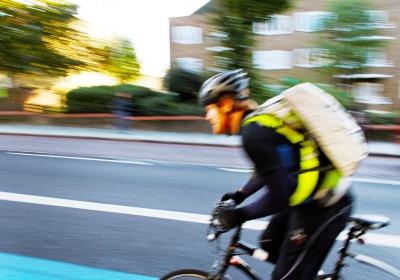'Drivers determine cycling safety'
Wed, 27 Nov 2013HIGH-VIS clothing on cyclists does not deter drivers from performing the "most dangerous" overtakes, scientists say.
Between 1% and 2% of drivers pass "dangerously close" to cyclists when overtaking, regardless of what they are wearing, a study found.
The average gap left by a driver overtaking a cyclist has shrunk over the past few decades from 179cm in 1979 to 118cm in 2013.
This suggests there is little a cyclist can do to prevent the riskiest manoeuvres from happening.
The University of Bath scientists are calling for roads and driver behaviour to change to make cycling safer, instead of targeting those on bikes.
"Many people have theories to say that cyclists can make themselves safer if they wear this or that," said Dr Ian Walker from the university's psychology department, who led the project and analysed the data.
"Our study suggests that no matter what you wear, it will do nothing to prevent a small minority of people from getting dangerously close when they overtake you."
The study asked whether drivers passing a cyclist responded to how they looked, anticipating that motorists would give more space to riders who seemed inexperienced and less to those who appeared highly skilled.
One member of the research team, Dr Ian Garrard from Brunel University in London, used an ultrasonic distance sensor to record how close each vehicle passed during his daily commute in Berkshire and outer London.
Each day he chose one of seven outfits at random. They ranged from tight Lycra racing clothing, signalling high experience, to a high-visibility vest with "novice cyclist" printed on the back to show inexperience.
He sometimes also wore a vest which stated he was video-recording his journey, or one modelled on a police jacket with "POLITE" printed on the back.
The same bicycle was used every day and was always ridden in the same way.
Dr Garrard collected data from 5,690 passing vehicles over several months.
Member of the research team, who are all regular cyclists, found that the vest mentioning video-recording showed a small increase in the average amount of space drivers left.
But there was no difference between the outfits in the most dangerous overtakes where motorists passed within 50cm, or under 20 inches, of the rider.
Between 1% and 2% of motorists overtook within this extremely close zone regardless of what Dr Garrard was wearing, the data shows.
The average gap left by drivers when overtaking a cyclist was 118cm, the University of Bath study said.
But research by the Transport Research Laboratory in 1979 measured the average gap drivers left when overtaking a cyclist as 179cm. This suggests the treatment of cyclists has become worse over the last few decades.
Dr Walker also found that long vehicles such as buses and trucks get closer to cyclists than cars when overtaking.
Edmund King, AA president, said: "All drivers should give cyclists adequate room when they overtake no matter what they are wearing, however, at this time of year it is easier to spot cyclists at night if their bikes have good lights and they are wearing fluorescent or brighter clothes.
"The 1 or 2 % of drivers found in the study to drive dangerously close to cyclists need to join the majority of drivers who do leave more room. We would like to see drivers give as much space as is practical and ideally six feet (182 cm) when overtaking cyclists."
By Claire Hayhurst, Press Association



